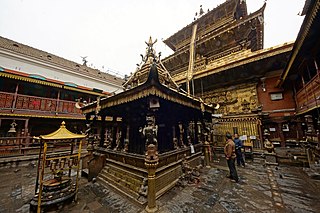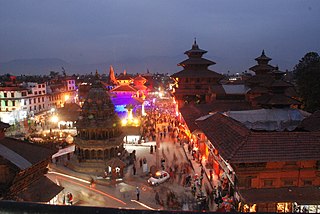
Kirtipur is an ancient city of Nepal. The Newars are the natives of Kipoo (Kirtipur) that is believed to be derived from Kirati King Yalamber. It is located in the Kathmandu Valley 5 km south-west of the city of Kathmandu. It is one of the five municipalities in the valley, the others being Kathmandu, Lalitpur, Bhaktapur and Madhyapur Thimi. It is one of the most famous and religious places to visit. Many people visit this place not only for its natural environment but also to visit temples. The city was listed as a UNESCO tentative site in 2008.

A chaitya, chaitya hall, chaitya-griha, refers to a shrine, sanctuary, temple or prayer hall in Indian religions. The term is most common in Buddhism, where it refers to a space with a stupa and a rounded apse at the end opposite the entrance, and a high roof with a rounded profile. Strictly speaking, the chaitya is the stupa itself, and the Indian buildings are chaitya halls, but this distinction is often not observed. Outside India, the term is used by Buddhists for local styles of small stupa-like monuments in Nepal, Cambodia, Indonesia and elsewhere. In the historical texts of Jainism and Hinduism, including those relating to architecture, chaitya refers to a temple, sanctuary or any sacred monument.

Nagbahal is located in the heart of the city of Lalitpur in the Kathmandu Valley in Nepal. Nagbahal was originally a Buddhist monastery, but the original buildings are now gone. What is left is a large courtyard. In spite of that, this bahal still retains its religious and cultural significance.

Nepali architecture or Nepalese architecture is a unique blend of artistic and practical considerations. Situated between the trade routes of India, Tibet and China, Nepali architecture reflects influences from these cultural strongholds. The pagoda architectural tradition figures prominently among Hindu temples in the country. In contrast, Buddhist temples reflect the Tibetan tradition of Buddhist architecture and the stupa features prominently. Mugal, summit and dome styles also have great scope in Nepal. Whilst significant influence for Nepal's architecture comes from India, there is also a distinct influence from the.

Swayambhu is an ancient religious complex atop a hill in the Kathmandu Valley, west of Kathmandu city. The Tibetan name for the site means 'Sublime Trees', for the many varieties of trees found on the hill. However, Shingkun may be of the local in Tamang Bhasa name for the complex, Swayambhu, meaning 'self-sprung'. For the Buddhist Newars, in whose mythological history and origin myth as well as day-to-day religious practice Swayambhunath occupies a central position, it is probably the most sacred among Buddhist pilgrimage sites. For Tibetans and followers of Tibetan Buddhism, it is second only to Boudha. Swayambhunath is the Hindu name.

The Sun Temple is a Hindu temple dedicated to the solar deity Surya located at Modhera village of Mehsana district, Gujarat, India. It is situated on the bank of the river Pushpavati. It was built after 1026-27 CE during the reign of Bhima I of the Chaulukya dynasty. No worship is offered now and is protected monument maintained by Archaeological Survey of India. The temple complex has three components: Gudhamandapa, the shrine hall; Sabhamandapa, the assembly hall and Kunda, the reservoir. The halls have intricately carved exterior and pillars. The reservoir has steps to reach the bottom and numerous small shrines.

Newa architecture is an indigenous style of architecture used by the Newari people in the Kathmandu valley in Nepal. It is a style used in buildings ranging from stupas and chaitya monastery buildings to courtyard structures and distinctive houses. The style is marked by striking brick work and a unique style of wood carving rarely seen outside Nepal. The style has been propagated by Nepalese architects including Arniko.

Newar Buddhism is the form of Vajrayana Buddhism practiced by the Newar people of the Kathmandu Valley, Nepal. It has developed unique socio-religious elements, which include a non-monastic Buddhist society based on the Newar caste system and patrilineality. The ritual priestly (guruju) caste, vajracharya and shakya form the non-celibate religious clergy caste while other Buddhist Newar castes like the Urāy act as patrons. Uray also patronise Tibetan Vajrayana, Theravadin, and even Japanese clerics. It is the oldest known sect of the Vajrayana tradition outdating the Tibetan school of Vajrayana by more than 600 years.

Baha is a type of courtyard found amongst Newar communities in Nepal. It is the most dominant type of courtyard in Newari Architecture. Baha is a term for Buddhist Monastery and derives its name from a Sanskrit word Bihara, meaning joy or enchantment and thus is a place of religious bliss.

Asan is a ceremonial, market and residential square in central Kathmandu, the capital of Nepal. It is one of the most well-known historical locations in the city and is famed for its bazaar, festival calendar and strategic location. Asan has been described as one of the fine Newar examples of a traditional Asian bazaar. The Tuladhar, Maharjan, Shrestha, Bajracharya and Shakya castes make up most of the population.

Hanuman Dhoka is a complex of structures with the Royal Palace of the Malla kings and also of the Shah dynasty in the Durbar Square of central Kathmandu, Nepal. It is spread over five acres. The Hanuman Dhoka Palace gets its name from the stone image of Hanuman, the Hindu deity, that sits near the main entryway. 'Dhoka' means door or gate in Nepali. The buildings were severely damaged in the 2015 earthquake.

Hiraṇyavarṇa Mahāvihāra, also Kwa Baha: informally called The Golden Temple with literal meaning "Gold-colored Great Monastery", is a historical vihara situated in Patan, Nepal.

Kathmandu Durbar Square is located in front of the old royal palace of the former Kathmandu Kingdom and is one of three Durbar Squares in the Kathmandu Valley in Nepal, all of which are UNESCO World Heritage Sites.

The architectural heritage of Kathmandu city is integral to that of the Kathmandu valley since all monuments have evolved over centuries of craftsmanship influenced by Hindu and Buddhist religious practices. The architectural treasure of the Kathmandu valley has been categorized under the well known seven groups of heritage monuments and buildings. In 2006, UNESCO declared these seven groups of monuments as a World Heritage Site (WHS). The seven monuments zones cover an area of 188.95 hectares, with the buffer zone extending to 239.34 hectares. The Seven Monument Zones (Mzs) inscribed originally in 1979 with a minor modification in inscribed year as 2006, are: Five monuments in Kathmandu – Durbar square of Hanuman Dhoka, Hindu temples of Pashupatinath and Changunarayan, the Buddha stupas of Swayambu and Boudhanath; and two monuments outside Kathmandu city limits, in the satellite towns of Patan and Bhktapur – Durbar square at Patan, Durbar square at Bhaktapur. Brief details of the five Kathmandu city monuments are elaborated here.

Bhaktapur Durbar Square is a former royal palace complex located in Bhaktapur, Nepal. It housed the Malla kings of Nepal from 14th to 15th century and the kings of the Kingdom of Bhaktapur from 15th to late 18th century until the kingdom was conquered in 1769. Today, this square is recognised by UNESCO managed jointly by the Archeological Department of Nepal and Bhaktapur Municipality and is under heavy restoration due to the damages from the earthquake in 1934 and the recent earthquake of 2015.

Patan Durbar Square is situated at the centre of the city of Lalitpur in Nepal. It is one of the three Durbar Squares in the Kathmandu Valley, all of which are UNESCO World Heritage Sites. One of its attractions is the ancient royal palace where the Malla Kings of Lalitpur resided.

Sankata Temple, is one of the temples located at Te Bahal, Kathmandu, Nepal. Sankata is a popular divinity who is worshipped, especially on Saturdays, to ward off bad luck and sickness. Sankata is worshiped by Buddhist as well who accredit the shrine to Chanda Mahoroshan. One of the curious things about the deity is that for Hindus, Sankata is a goddess while Buddhist take the deity as God Bhairav.

Ashok Binayak is a Hindu temple located in Kathmandu district at eastern side of Kathmandu Durbar Square in Maru Tole. This temple is of Lord Ganesha also known as Binayak. The god is worshipped as the god of luck by Hindus. The temple hosts one of the four original Ganesh shrines of Kathmandu valley. It is a popular place of worship for Hindus.It is worshipped both by Hindus and Buddhists. The temple is visited during Tuesdays every week as it is the day which is considered the day of Ganesh.

Jana Bahal, often called Janabahaa: and also called Machindra Bahal and less frequently Kanak Chaitya Mahavihar, is one of the few Bahal which have fully fledged storied temple standing in the middle of a court. The main deity residing in the temple is the Seto Machindranath also known as Janabaha Dyo, Aryavalokitesvara, Karunamaya and Guanyin.






















